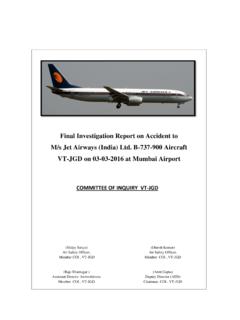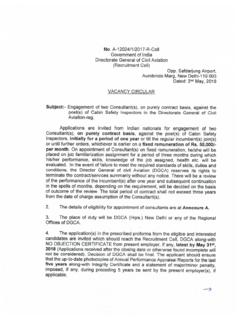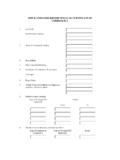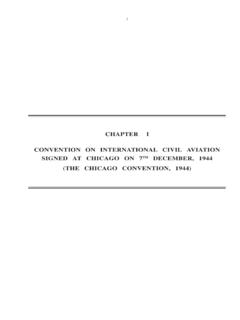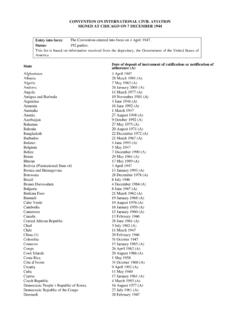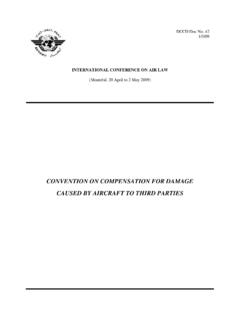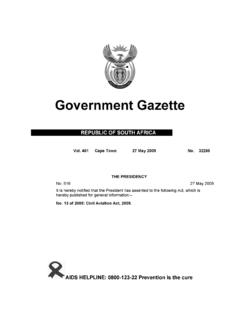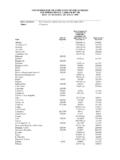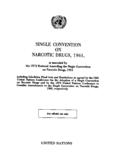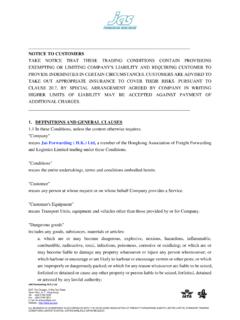Transcription of MINISTRY OF CIVIL AVIATION NOTIFICATION
1 MINISTRY OF CIVIL AVIATION NOTIFICATION New Delhi, the 19th January, 2012 34(E).- Whereas certain draft of the Aircraft (Security) Rules 2011 were published as required by Section 14 of the Aircraft Act 1934 vide the NOTIFICATION of the Government of India in the MINISTRY of CIVIL AVIATION No. 109 dated 25 March, 2011 in Gazette of India, Part II, Section 3, sub section (i) dated 25 March, 2011 for inviting objection and suggestion from all persons likely to be affected thereby before expiry of the period of forty-five days from the date of publication of the said rules in the Official Gazette; And whereas, no objections and suggestions were received from the public on the said draft rules: Now, therefore, in exercise of the powers conferred by section 4 read with section 5 of the Aircraft Act, 1934, the Central Government hereby makes following rules, namely: PART I PRELIMINARY 1.
2 Short title, extent and commencement (1) These rules may be called the Aircraft (Security) Rules, 2011. (2) They shall extend to whole of India and apply also to (a) an aircraft registered in India, and to persons on an aircraft operated by an operator who has his principal place of business or permanent residence in India, wherever they may be; (b) all aircrafts in India. (3) They shall come into force on the date of their final publication in the Official Gezette. 2. Definitions (1) In these rules unless there is anything repugnant in the subject or context;- (a) Act means the Aircraft Act, 1934 (22 of 1934); (b) aerodrome operator means a person, organisation or enterprise responsible for operation and management of an aerodrome; (c) aerodrome entry permit means the photo identity card, smart card or temporary permit issued by the Commissioner of Security ( CIVIL AVIATION ), Bureau of CIVIL AVIATION Security, MINISTRY of CIVIL AVIATION or any person authorized by the Central Government for entry into the aerodrome or part of an aerodrome.
3 (d) aircraft operator means a person, organisation or enterprise engages in or offering to engage in an aircraft operation; (e) acts of unlawful interference means acts or attempted acts to jeopardize the safety of CIVIL AVIATION and air transport, including- (i) unlawful seizure of aircraft in flight; (ii) unlawful seizure of aircraft on the ground; (iii) hostage-taking on board aircraft or on aerodromes; (iv) forcible intrusion on board an aircraft, at an aerodrome or on the premises on an aeronautical facility; (v) introduction on board an aircraft or at an aerodrome of a weapon or hazardous device or material intended for criminal purposes; (vi) communication of false information with a view to jeopardize the safety of an aircraft in flight or on the ground, of passengers, crew, ground personnel or the general public, at an aerodrome or on the premises of a CIVIL AVIATION facility; (f) airside means the movement area of an aerodrome, adjacent terrain and building or portions thereof access to which is controlled; (g) Commissioner means the Commissioner of Security ( CIVIL AVIATION ), Bureau of CIVIL AVIATION Security, MINISTRY of CIVIL AVIATION who shall be appropriate authority for the requirements of Annex 17.
4 (h) AVIATION Security Group means an unit of specialized Government agency authorized by the Commissioner to safeguard CIVIL AVIATION against acts of unlawful interference and protection of property at the aerodrome handling CIVIL AVIATION ; (i) Cabin baggage means a baggage intended for carriage in the cabin of an aircraft; (j) Convention means the Convention relating to International CIVIL AVIATION signed at Chicago on the 7th day of December, 1944; (k) express cargo means goods other then mail and accompanied or baggage involuntarily or inadvertently separated from passengers or crew which is required to be carried on priority basis by an aircraft operator; (l) In-flight security officer means Government security personnel deployed on board an aircraft for maintaining security of aircraft against any acts of unlawful interference; (m) mail means dispatches of correspondence and other objects tendered by and intended for delivery to postal administrations; (n) movement area means the area of an aerodrome which is intended for the surface movement of an aircraft and includes the man powering area and aprons.
5 (o) national CIVIL AVIATION security programme means such programme established by an officer authorized by Central Government in this behalf to give effect to any annex of the Convention with the prior approval of central Government; (p) officer means a person appointed or employed in any office by Government of India; (q) prohibited article means an object which can be used to commit an act of unlawful interference an which has not been properly declared; (r) public aerodrome means an aerodrome which has been licensed for use by public at large; (s) regulated agent means an agent, freight forwarder or any other entity who conducts business with an operator and provides security controls that are accepted or required by the Commissioner in respect cargo, courier and express parcels or mails to be transported by air; (t) screening means the application of technical or other means which are intended to indentify or detect weapons, explosives or other dangerous devices which may be used to commit an act of unlawful interference with CIVIL AVIATION ; (u) security means a combination of measures, human and material resources intended to be used to safeguard CIVIL AVIATION against acts of unlawful interference.
6 (v) security accident means an occurrence which results in death or grievous hurt to a person or major damage to the property; (w) security clearance means compliance with the security controls specified in the national CIVIL AVIATION security programme with regard to any aircraft, person or object; Explanation:- For the purposes of this clause grievous hurt shall have the meaning assigned to it in Indian Penal Code 1860; (x) security restricted area means airside areas of an airport into which access is controlled to ensure security of CIVIL AVIATION including passenger areas between the screening check point and the aircraft, the ramp, baggage mark up area, cargo sheds, mail center, airside catering and aircraft cleaning premises; (y) security incident in relation to CIVIL AVIATION security means an occurrence, which takes place either on the ground or in flight, which results (i) in injury to a person, damage to property, fire and breakage.
7 (ii) contravention or breach of security laws, regulations, national CIVIL AVIATION security programme and orders issued by the Central Government under the provision of the Act; (z) security control means the method by which the introduction of weapon, explosive or other dangerous device, article or substance, which may be used to commit an act of unlawful interference, can be prevented; (za) security programme means written measures specified by the Commissioner to be adopted by an entity to safeguard CIVIL AVIATION against acts of unlawful interference; (zb) terminal means the building or group of buildings and includes arrival building where screening of passenger, baggage, cargo and courier bag is done and boarding on aircraft takes place; (zc) unattended baggage means baggage at an aerodrome with or without a baggage tag which is not picked up by or indentified by a passenger or any other person; (zd) vital installation means any facility on or connected with an aerodrome, which , if damaged or destroyed, would seriously impair the functioning of the aerodrome.
8 (2) Words and expressions used herein and not defined but defined in the Act shall have the same meaning as is assigned to them in the Act. 3. Duties of The commissioner shall;- (a) establish, develop, implement, maintain and review the national CIVIL AVIATION security programme consistent with the provisions of Annes-17 to the convention to safeguard CIVIL AVIATION operations against acts of unlawful interference and threat perception taking into account the safety, regularity and efficiency of flights; (b) make order necessary to carry out national CIVIL AVIATION security programme; (c) respond immediately to meet any increased security threat; (d) define and allocate tasks and coordinate activities between the departments, agencies and other organisation of the State Government, aerodrome and aircraft operators and other entities concerned with or responsible for the implementation of various aspects of the national CIVIL AVIATION security programme; (e) establish an national AVIATION security committee or similar arrangements for the purpose of coordinating security activities between the departments, agencies and other organisations, aerodrome and aircraft operators and other entities concerned with or responsible for the implementation of various aspects of the national CIVIL AVIATION security programme.
9 (f) establish, develop and implement national CIVIL AVIATION security training programme for personnel of all entities involved with or responsible for the implementation of various aspects of the national CIVIL AVIATION security programme which shall be designed to ensure the effectiveness of the said security programme; (g) designate an authority at each aerodrome serving CIVIL AVIATION who shall be responsible for coordinating the implementation of security controls; (h) establish aerodrome security committee at each aerodrome serving CIVIL AVIATION for coordinating the implementation of security controls and procedures as specified in the aerodrome security programme; (i) develop, implement and maintain a national CIVIL AVIATION security quality control programme to determine compliance with and validate the effectiveness of its national CIVIL AVIATION security programme; (k) establish and implement policy and procedure to adjust relevant element of its national CIVIL AVIATION security programme accordingly, based upon a security risk assessment carried out by the national security agencies.
10 4. Appeals. If any person is aggrieved by an order passed by an officer in exercise of a powers conferred on him by
